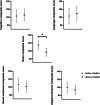Long Term Developmental Consequences of Short Apneas and Periodic Breathing in Preterm Infants
- PMID: 40637462
- PMCID: PMC12243723
- DOI: 10.1002/ppul.71193
Long Term Developmental Consequences of Short Apneas and Periodic Breathing in Preterm Infants
Abstract
Objective: Preterm infants frequently experience short apneas which can occur in isolation or in a repetitive pattern termed periodic breathing. We assessed the consequences of the amount of time spent with short apneas on developmental outcomes at 2 years of age.
Methods: Preterm infants (N = 23) born between 28 and 32 weeks gestational age were studied during daytime sleep in the supine position at 32-36 weeks post menstrual age (PMA), 36-40 weeks PMA, 3 months and 6 months corrected age. The percentage of total sleep time (TST) spent with apneas at each study was calculated. Infants were divided into those below and above the median cumulative time spent with apneas over the 4 studies (28.4% TST) and developmental assessments (Bayley Scales of Infant Development III, Early Childhood Behavior Questionnaire, Child Behavior Check List) at 2 years of age were compared with ANCOVA.
Results: The above median group tended to have lower unadjusted scores for motor composite, social emotional composite and adaptive behavior composite on the Bayley's. After adjusting for confounders and %TST spent with apneas, the motor composite score was significantly lower in the above median group (p < 0.05). Perceptual Sensitivity was lower in the above median group (p < 0.05).
Conclusions: In clinically stable very preterm infants, who had been discharged home with no concerns of respiratory instability, those infants who spent more time with short apneas, particularly periodic breathing, had reduced motor outcomes at 2 years of age. Our findings add to a growing literature suggesting that short apneas and periodic breathing are not benign.
Keywords: developmental outcomes; periodic breathing; preterm infant; sleep.
© 2025 The Author(s). Pediatric Pulmonology published by Wiley Periodicals LLC.
Conflict of interest statement
The authors declare no conflicts of interest.
Figures




Similar articles
-
Short apneas and periodic breathing in preterm infants in the neonatal intensive care unit-Effects of sleep position, sleep state, and age.J Sleep Res. 2025 Feb;34(1):e14253. doi: 10.1111/jsr.14253. Epub 2024 Jun 4. J Sleep Res. 2025. PMID: 38837291 Free PMC article.
-
Early developmental intervention programmes provided post hospital discharge to prevent motor and cognitive impairment in preterm infants.Cochrane Database Syst Rev. 2015 Nov 24;2015(11):CD005495. doi: 10.1002/14651858.CD005495.pub4. Cochrane Database Syst Rev. 2015. Update in: Cochrane Database Syst Rev. 2024 Feb 13;2:CD005495. doi: 10.1002/14651858.CD005495.pub5. PMID: 26597166 Free PMC article. Updated.
-
Early developmental intervention programmes provided post hospital discharge to prevent motor and cognitive impairment in preterm infants.Cochrane Database Syst Rev. 2024 Feb 13;2(2):CD005495. doi: 10.1002/14651858.CD005495.pub5. Cochrane Database Syst Rev. 2024. PMID: 38348930 Free PMC article.
-
Different corticosteroids and regimens for accelerating fetal lung maturation for babies at risk of preterm birth.Cochrane Database Syst Rev. 2022 Aug 9;8(8):CD006764. doi: 10.1002/14651858.CD006764.pub4. Cochrane Database Syst Rev. 2022. PMID: 35943347 Free PMC article.
-
Early developmental intervention programmes post-hospital discharge to prevent motor and cognitive impairments in preterm infants.Cochrane Database Syst Rev. 2012 Dec 12;12:CD005495. doi: 10.1002/14651858.CD005495.pub3. Cochrane Database Syst Rev. 2012. Update in: Cochrane Database Syst Rev. 2015 Nov 24;(11):CD005495. doi: 10.1002/14651858.CD005495.pub4. PMID: 23235624 Updated.
References
-
- Ohuma E. O., Moller A. B., Bradley E., et al., “National, Regional, and Global Estimates of Preterm Birth in 2020, With Trends From 2010: A Systematic Analysis,” Lancet 402, no. 10409 (2023): 1261–1271. - PubMed
-
- Allotey J., Zamora J., Cheong‐See F., et al., “Cognitive, Motor, Behavioural and Academic Performances of Children Born Preterm: A Meta‐Analysis and Systematic Review Involving 64 061 Children,” BJOG: An International Journal of Obstetrics & Gynaecology 125, no. 1 (2018): 16–25. - PubMed
-
- Eichenwald E. C., Watterberg K. L., Aucott S., et al., “Apnea of Prematurity,” Pediatrics 137, no. 1 (2016): e20153757. - PubMed
-
- Poets C. F., “Intermittent Hypoxia and Long‐Term Neurological Outcome: How Are They Related?,” Seminars in Fetal and Neonatal Medicine 25, no. 2 (2020): 101072. - PubMed
-
- American Academy of Sleep Medicine . AASM Manual for the Scoring of Sleep and Associated Events: Rules, Terminology and Technical Specifications. 2018, https://aasm.org/clinical-resources/scoring-manual/.
MeSH terms
LinkOut - more resources
Full Text Sources
Medical

